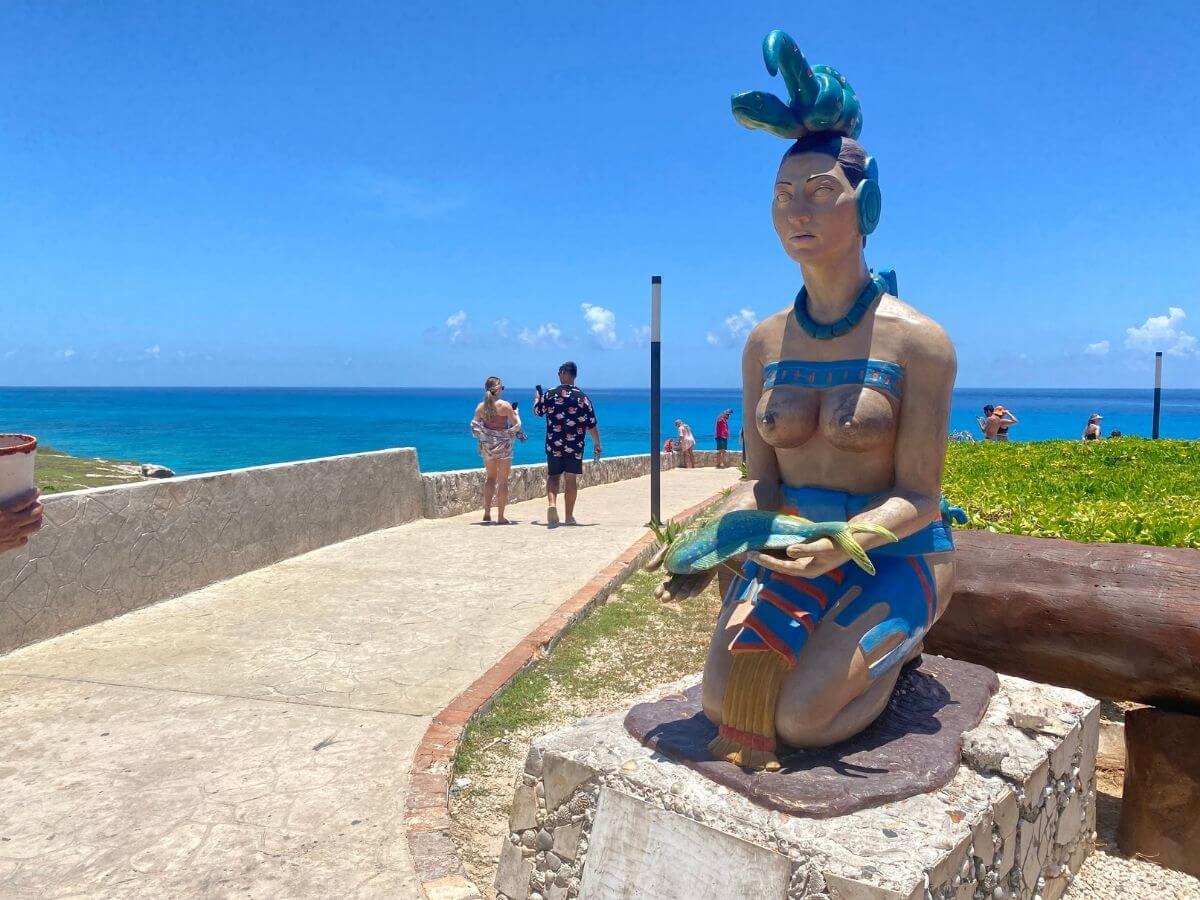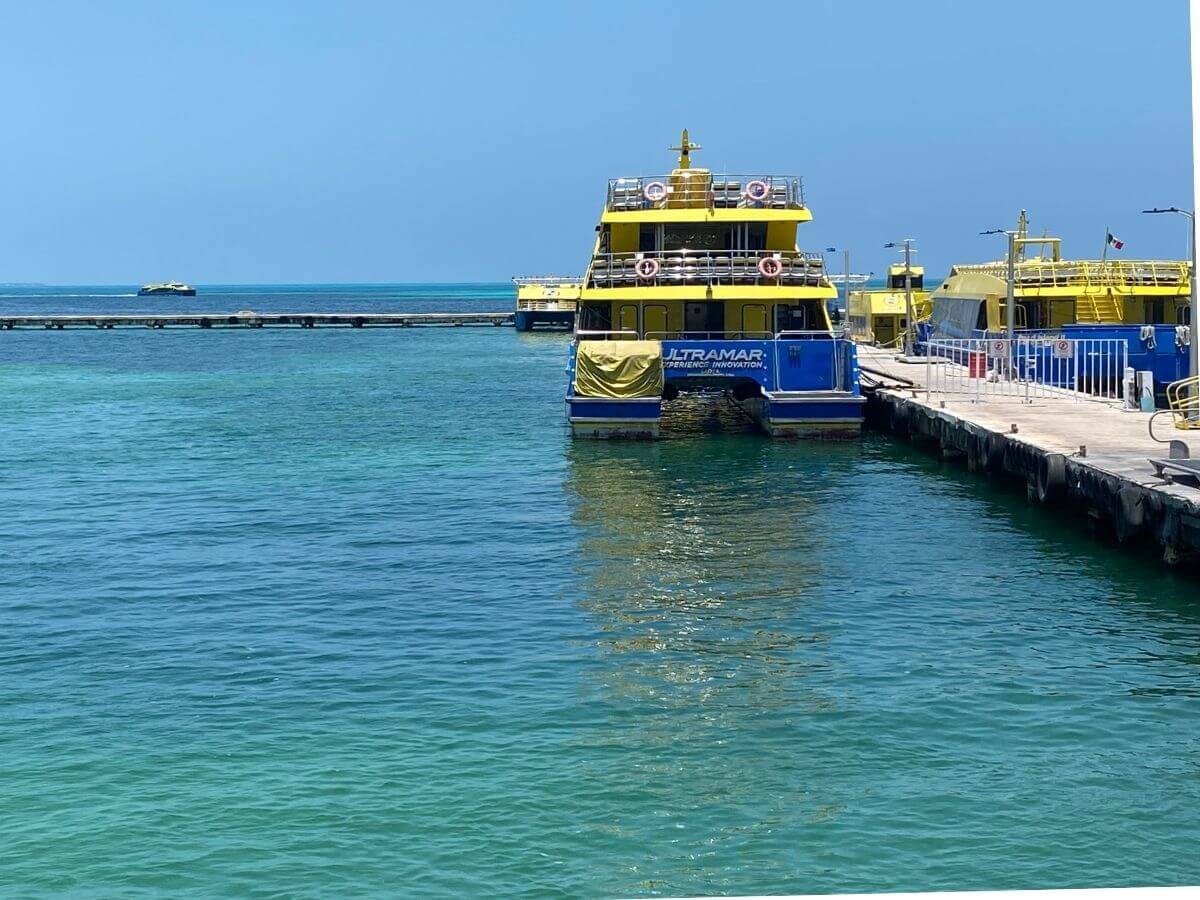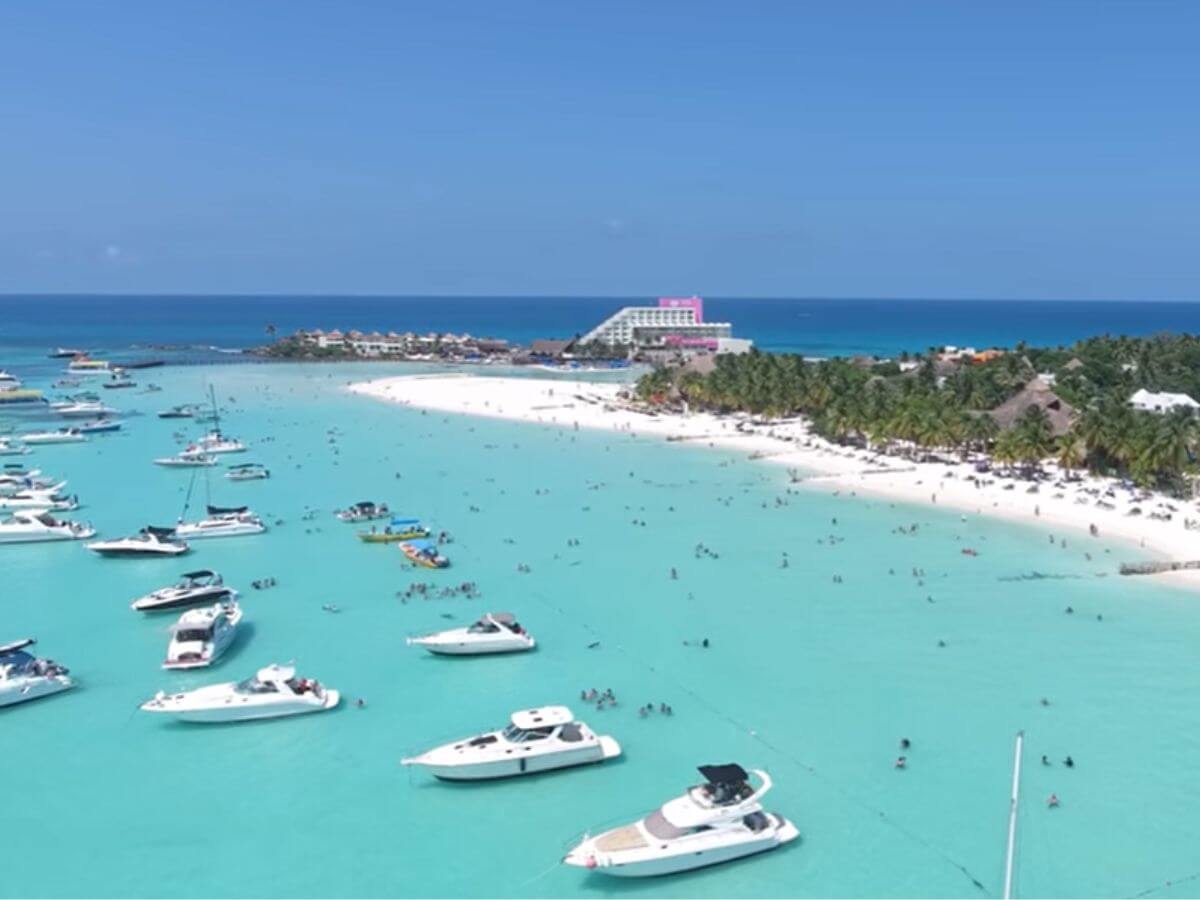Contents
- The History of Isla Mujeres: A Tale of Mayan Deities, Conquistadors, Pirates and Peace
- The Pre-Hispanic Era: A Sacred Place for Mayan Women
- Isla Mujeres and the Mayan Salt Trade
- The Arrival of Spanish Conquerors: Tides of Change
- The Era of Pirates and Buccaneers
- Archaeological Discoveries on the Island of Women
- Isla Mujeres Today
The History of Isla Mujeres: A Tale of Mayan Deities, Conquistadors, Pirates and Peace
Just off the coast of Cancun, surrounded by the warm waters of the Mexican Caribbean Sea, lies the beautiful island of Isla Mujeres. This small island, whose name translates to “Women Island” or “Island of Women,” offers a tranquil retreat from the hustle of the mass tourism of the Yucatán Peninsula.
With its white sandy beaches, turquoise waters, and lush landscapes, Isla Mujeres has become a sought-after destination for travelers seeking a slice of paradise. Yet, beyond its natural beauty, the island holds a fascinating history that dates back to pre-Hispanic times.
The history of Isla Mujeres is as captivating as its beauty, intertwined with tales of Mayan goddesses, fearless pirates, and Spanish conquerors. The island’s past is a vibrant blend of cultures, adventures, and natural wonders, making it a living testament to the region’s historical evolution.
Isla Mujeres: What´s in a Name?
The name “Isla Mujeres” or the “Island of Women” was coined by Spanish explorers upon their arrival to the island in the 16th century. The conquistadors, led by Francisco Fernández de Córdoba, were both intrigued and mystified to find numerous hand-carved, female figures on the island. These statues, fashioned from clay, stone and even gold into the female form, were part of the Mayan religious practices, dedicated to the goddess Ixchel.

The Pre-Hispanic Era: A Sacred Place for Mayan Women
Isla Mujeres has a rich history stretching back over 1500 years and was once an integral part of the Mayan province of Ekab. Remnants of this lost civilization can be seen at the archeological site El Meco in what is now Cancun. The island was held in high reverence as a sanctuary dedicated to the goddess Ixchel, the Mayan goddess of fertility.
The sacred essence of the island was particularly significant for Mayan women, who would embark on pilgrimages to the island to pay homage to Ixchel, seeking her blessings for fertility and childbirth. The journey to Isla Mujeres was considered a rite of passage for many Mayan women, symbolizing their devotion and connection to the divine feminine.
The name “Isla Mujeres” not only highlights the island’s pre-Hispanic religious significance but also its unique identity which captivates the imaginations of those from afar. Indeed, the enduring mystique of the Goddess Ixchel and her court of women can still be seen today all over the island in local art and handicrafts.
Goddess Ixchel and the Temple at Punta Sur
The Temple of Ixchel, nestled at Punta Sur, at the highest point above sea level, is thought to have served dual purposes. It was a religious site where rituals and ceremonies in honor of Ixchel were conducted, and it also functioned as a lighthouse for navigators arriving by sea. The ingenious design of the temple allowed light from torches to shine through holes in the walls, providing guidance and safe passage to sailors at night as they approached the rocky cliffs on the east side of the island.

While the ruins at the southernmost tip of Isla Mujeres are often associated with the temple of Ixchel, recent evidence suggests that even more Mayan ruins await discovery on the island. Some theories propose that the true temple of the Mayan Goddess Ixchel might be located elsewhere on the island.
Isla Mujeres and the Mayan Salt Trade
Beyond its religious significance, Isla Mujeres was a pivotal site for salt harvesting, a practice crucial to the Mayan economy. The salt lagoons on the island were meticulously exploited for this valuable commodity, which was not only essential for food preservation but also held symbolic value within Mayan culture. The island’s role in the Mayan salt trade underscores its connection to the broader socio-economic fabric of the Mayan civilization that spanned across the Yucatan Peninsula.
The discovery of Mayan ruins and artifacts at Hacienda Mundaca unveils a deeper link between Isla Mujeres and the extensive Mayan civilization that once flourished in the region. The remnants of Mayan culture found on the island provide a glimpse into the intricate network of trade, religion, and cultural exchange that characterized the Mayan era, painting a vivid picture of a civilization deeply intertwined with the natural and spiritual realms.
The Arrival of Spanish Conquerors: Tides of Change
The year 1517 marked a pivotal moment in the history of Isla Mujeres with the arrival of Spanish conquistadors led by Francisco Fernández de Córdoba. Sailing from Cuba, they were on a quest for slaves and new lands when they stumbled upon this quaint island off the Yucatan Peninsula. The untouched beauty of the island and its serene shores were a stark contrast to the turbulent times that lay ahead with the arrival of these foreign invaders.
The interactions between the Mayan people and the Spanish conquerors were far from harmonious. The Spanish were driven by their quest for gold, slaves, and the expansion of their empire, which led to inevitable conflicts with the native Mayan people. The island became a scene of struggle and resistance as the Mayan people fought to protect their land and culture from foreign domination. Slave traders introduced a dark chapter in the island’s history as many were captured and sold, marking a period of oppression and exploitation.
The Spanish conquerors also introduced Christianity to the island, attempting to replace the native Mayan religious practices. The old temples were overshadowed by new Christian churches, and the ancient traditions were gradually replaced or merged with Christian practices. This period saw a significant transformation in the cultural and religious landscape of Isla Mujeres, as the echoes of the ancient Mayan civilization started to fade, making way for a new era of Spanish influence that would shape the island’s future.
The Era of Pirates and Buccaneers
The strategic location of Isla Mujeres, nestled in the heart of the Caribbean Sea, made it a haven for some of the most famous pirates and notorious buccaneers of the time. Among them were the infamous Henry Morgan and Jean Lafitte, whose names sent shivers down the spines of many. The island’s secluded coves and hidden bays provided the perfect hideout for these sea rogues, allowing them to launch surprise attacks on passing ships and retreat to their secret lairs with their ill-gotten gains.
The pirates’ activities in the Caribbean Sea were the stuff of legends, with tales of daring sea battles, hidden pirate coves, and buried treasures waiting to be discovered by the most adventurous souls. Legends and tales of buried treasures on the island have been whispered through the ages, adding a layer of mystique to the colorful history of Isla Mujeres.
The Legend of Fermin Mundaca
In the 19th century, mercenary, and pirate, Fermin Antonio Mundaca y Marechega disembarked at Isla Mujeres shores. Among the many pirates who sought refuge on Isla Mujeres, Fermín Mundaca’s tale is one of love and legacy. It’s said that Mundaca fell hopelessly in love with a local woman, Martiniana (Prisca) Gomez Pantoja, more commonly known as “La Trigueña,”. To win her heart, he built a magnificent estate known as Hacienda Vista Alegre, which is known today as Hacienda Mundaca. Despite his grand gesture, his love was unrequited. The love of his life married another man, leaving Mundaca heartbroken.
If you visit Isla Mujeres today, you can see his grave in the cemetery. It is carved with the mark of the pirate and an inscription that reads “As you are, I was. As I am, you will be.”, a haunting message to his one true love. Legend holds that Mundaca left the island for Merida where it said he went mad and died of a broken heart. The grave on the island lies empty but is an interesting point of interest for those fascinated by the history of Isla Mujeres.
Hacienda Mundaca stands as a testament to this pirate’s love and his life on Isla Mujeres. The estate showcases a blend of architectural styles, with lush gardens, stone archways, and a well-preserved main house. It’s a slice of the island’s pirate history, nestled amidst the natural beauty of Isla Mujeres. The ruins of Hacienda Mundaca are now among the island´s main attractions and the perfect place for visitors to step back in time and explore the romantic and adventurous tales of the pirate era that once swept across this beautiful island.
Archaeological Discoveries on the Island of Women
Recently, the National Institute of History and Anthropology (INAH) made a significant announcement regarding the discovery of Mayan ruins and various artifacts on Isla Mujeres, particularly at Mundaca Hacienda. The findings include remnants of five Mayan buildings, one of which is speculated to be the true temple of the goddess Ixchel.
The traditional belief was that the temple of Ixchel, the Mayan Goddess of the moon and fertility, was situated at Punta Sur, the southern tip of Isla Mujeres. This temple also reportedly served as a lighthouse, aiding ancient navigators with torch lights shown through holes in the temple walls.
However, recent discoveries by INAH suggest that the real temple of Ixchel might be among the ruins found on the property of Hacienda Mundaca. This revelation opens up new discussions and theories regarding the island’s historical and religious significance during the pre-Hispanic era. This theory challenges the earlier belief that the temple was located at the south point of the island, which might have served merely as a lighthouse.
Isla Mujeres Today
As the pirate era faded into the annals of history, Isla Mujeres began its transition into a quaint fishing village. The islanders turned to the abundant Caribbean Sea for sustenance, establishing a community deeply rooted in fishing traditions. This shift marked a period of relative peace and tranquility on the island, contrasting sharply with the turbulent pirate-infested days of yore.
The 20th century heralded a new era for Isla Mujeres as the winds of tourism began to blow across its shores. The establishment of ferry services from Puerto Juarez in the 1970s opened up the island to a world of possibilities, allowing visitors to easily travel the short distance from the mainland to this Caribbean haven. The influx of visitors brought a new wave of economic opportunities, gradually transforming the island from a sleepy fishing village to a burgeoning tourist hotspot.

With its beautiful beaches and clear shallow waters, it is no wonder that Isla has become such a popular destination and the ideal place to steal away for a day, away from the hustle and bustle on the mainland.
The underwater world of Isla Mujeres began to draw attention with the development of scuba diving spots. The discovery of the Cave of the Sleeping Sharks by marine biologist Ramón Bravo put the island on the map for diving enthusiasts. Explorations by Bravo and his colleague Jacques Cousteau shone a spotlight on the island’s marine life and attracted a new breed of adventurers keen on exploring the depths of the Caribbean Sea.
Positioned just off the Mesoamerican Barrier Reef, the second largest reef system in the world, underwater enthusiasts from around the world flock to Isla Mujeres to snorkel and SCUBA dive The island’s coral reefs are a vibrant underwater spectacle, teeming with a myriad of marine life. The seasonal arrival of whale sharks to the warm waters surrounding the island offers a unique opportunity for close encounters with these gentle giants, while the presence of sea turtles adds to the island’s allure for nature lovers.
In 2015, Isla Mujeres was granted the coveted Pueblo Mágico (Magical Village) status by Mexico’s Secretary of Tourism. This program recognizes towns all across Mexico that provide visitors with a “magical” experience, whether it is their natural beauty, cultural riches or historical relevance. The people of Isla Mujeres work hard to welcome visitors and prove that Isla is worthy of this distinction.
The remnants of Mayan temples, the ruins of pirate haciendas, and the quaint charm of its fishing heritage blend seamlessly with the vibrant tourism scene of today providing a welcome escape from the rampant development in Cancun, Playa del Carmen and Tulum.
As you can see, the allure of Isla is not only confined to its picturesque Playa Norte (North Beach) or the breathtaking views from Punta Sur. The history of Isla Mujeres is richly woven with tales of ancient Mayan civilization, daring pirates and Spanish conquests, all culminating in its modern-day reputation as a world-renowned travel destination.


